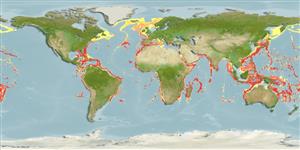Common names from other countries
Environment: milieu / climate zone / depth range / distribution range
экология
пелагический; пределы глубины 100 - 1750 m (Ref. 1695). Tropical; ? - 10°C (Ref. 1695); 69°N - 32°S, 89°W - 160°W
Circumglobal in tropical and subtropical oceanic waters. Tropical to polar.
Length at first maturity / Size / Вес / Возраст
Maturity: Lm ?, range 30 - ? cm Max length : 4.5 cm ML самец/пол неопределен; (Ref. 1695)
Minimum depth from Ref. 106682. Rarely exceeds 4.5 cm ML (Ref. 1695). Migrates from 550 to 1000 meters during the day, and 100 to 300 meters at night (Ref. 106682). Young is captured at depths 1,000 to 1,750 m, which suggests that females lay eggs on bottom of continental slopes (Ref. 1695). Dead shells washed up on the beaches often in large numbers (Ref. 88739).
Life cycle and mating behavior
половая зрелость | размножение | нерест | икра | Fecundity | личинки
Members of the class Cephalopoda are gonochoric. Male and female adults usually die shortly after spawning and brooding, respectively. Mating behavior: Males perform various displays to attract potential females for copulation. During copulation, male grasp the female and inserts the hectocotylus into the female's mantle cavity where fertilization usually occurs. Life cycle: Embryos hatch into planktonic stage and live for some time before they grow larger and take up a benthic existence as adults.
Основная ссылка
ссылки | координатор | соавторы
Jereb, P. and C.F.E. Roper (eds.). 2005. (Ref. 1695)
Статус Красного Списка МСОП (Ref. 130435)
Статус СИТЕС (Ref. 108899)
Not Evaluated
Not Evaluated
Использование человеком
| FishSource |
инструменты
дополнительная информация
Возраст/РазмерыростЗависимость между длиной и массой телаЗависимость между длинамиморфологияличинкичисленность
ресурсы в Интернет
Estimates based on models
Preferred temperature
(Ref.
115969): 4.7 - 11.6, mean 7.1 (based on 951 cells).
Категория цены
Unknown.
